
By:
- Heather Buschman
- Tiffany Fox
Published Date
By:
- Heather Buschman
- Tiffany Fox
Share This:
Beyond the March for Science
Organizers and backers of march look at next steps to increase public engagement in support for science
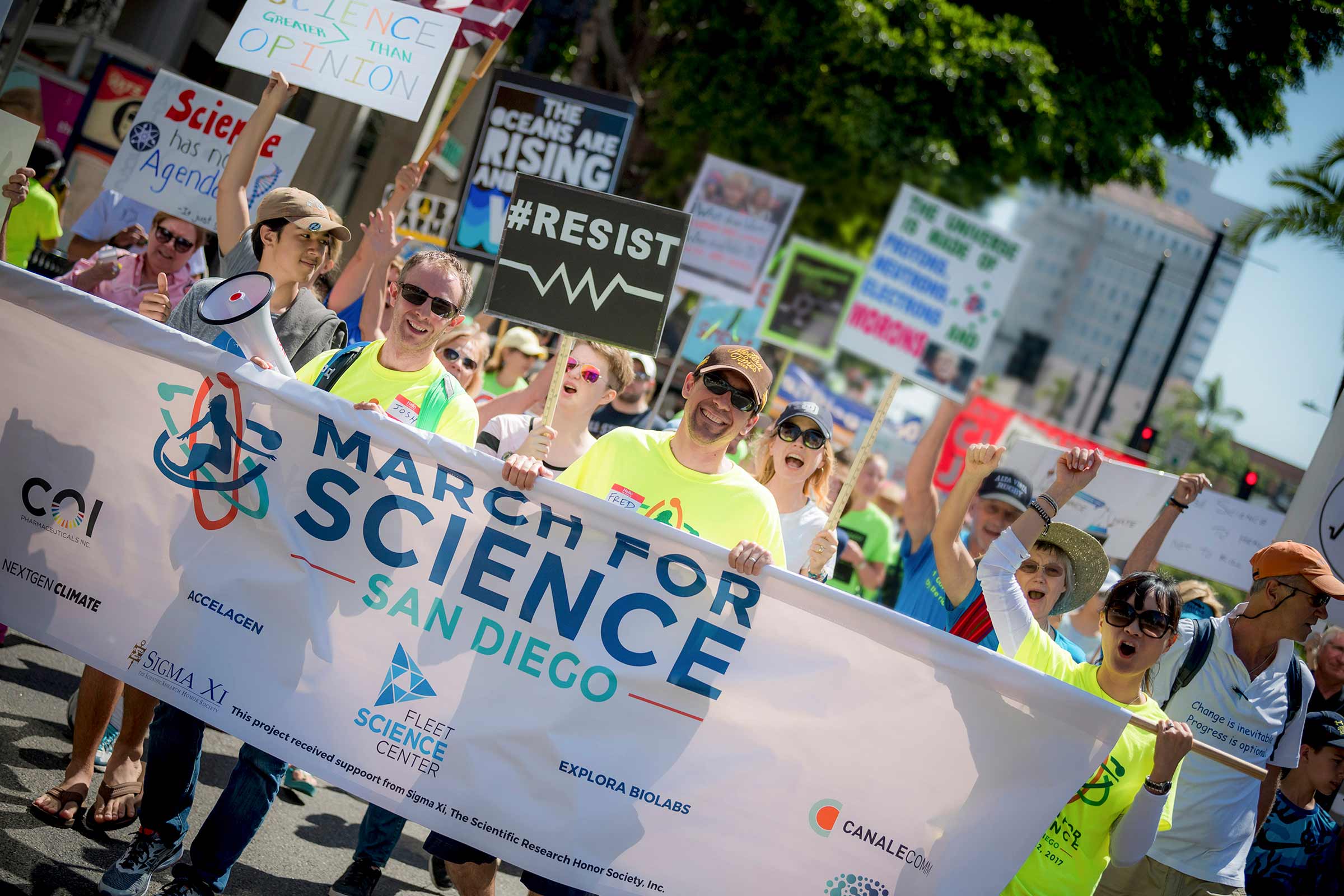
Photos by Erik Jepsen/UC San Diego Publications
On April 22, tens of thousands of people around the world — scientists and non-scientists alike — marched through the streets of Washington, D.C., San Diego and more than 600 other cities to celebrate science and encourage environmental protection, science literacy, evidenced-based policies and strong federal research funding. Hundreds of UC San Diego community members took part around the world, some even “marching” underwater and on a research vessel off the coast of San Diego.
Many marchers reported feeling energized after being surrounded by so many people enthusiastically supporting all aspects of science, as a catalyst for improving lives and the environment, and simply as a way of thinking.
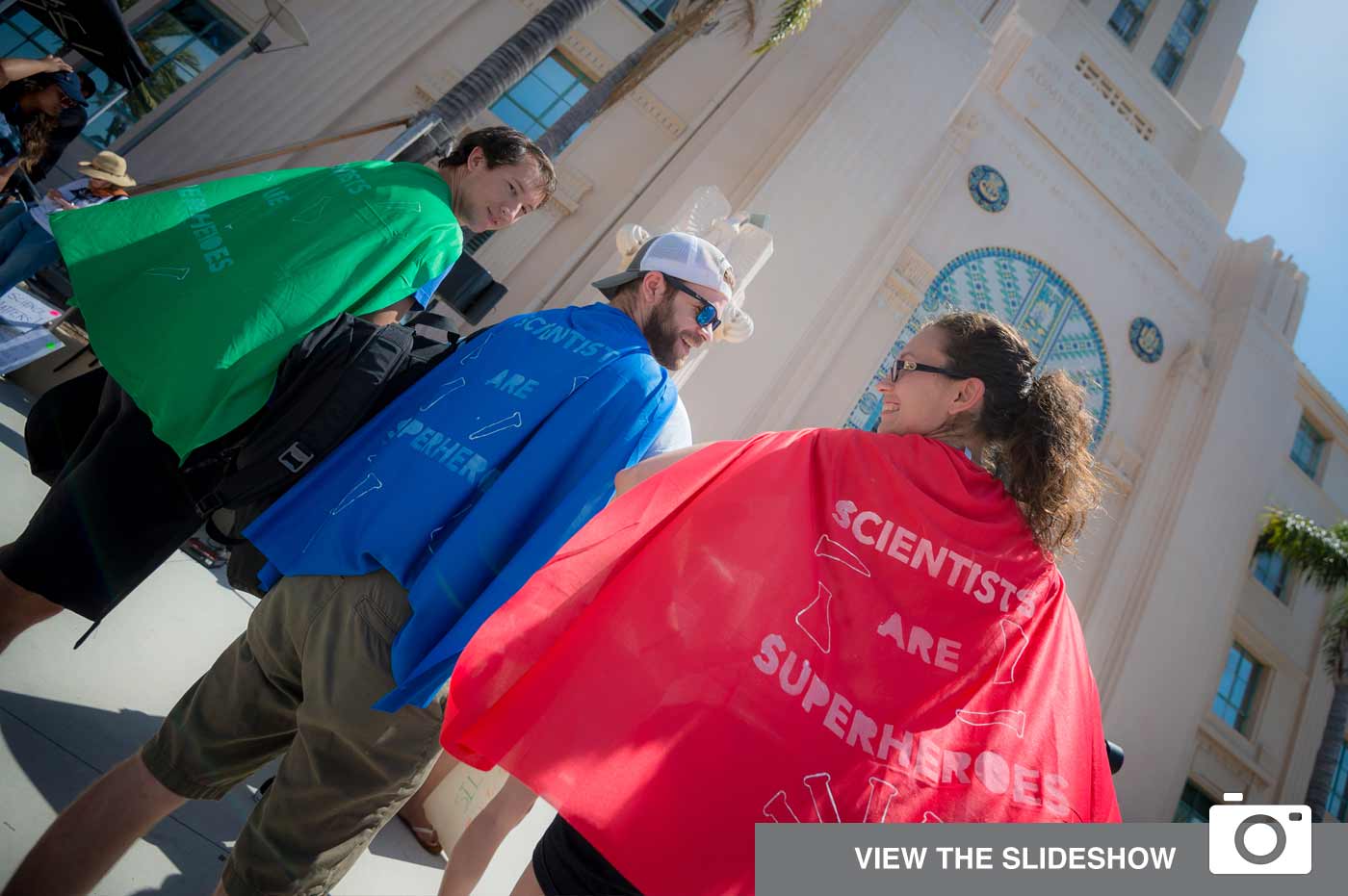
“I was very inspired by the passion and creativity of young aspiring scientists, as well as the large crowd representing so many branches of science,” said Steffanie Strathdee, director of the Global Health Institute in the UC San Diego School of Medicine. “I think the event was important to teach the future generation that we cannot take evidence-based decision making and federal funding for STEM for granted. And that we need to stand together and fight to protect the planet.” Strathdee marched in San Diego with her husband, Tom Patterson, professor of psychiatry, whose life was recently saved by experimental phage therapy at UC San Diego Health.
There was no shortage of creativity in the array of signs held high at the marches. Nerdy jokes, slogans written in elements of the periodic table and amino acids, puns about everything from antibodies to restriction enzymes, pleas to save the earth and political zingers made for a memorable day that will likely live on for months in the form of Facebook posts and internet memes.
“Something that really stuck out to me was the tremendous support we saw from those involved in not just the sciences, but also the humanities,” said Diana Hereld, research assistant in the UC San Diego departments of Music and Psychology who helped organize and promote the San Diego march. “As someone who is constantly toeing the line between art and science in my own research, it was meaningful to hear some of our speakers emphasize that the two fields are not antithetical.”
SAN DIEGO
The scientists who addressed the San Diego crowd—at least 15,000 strong—before and after the march shared their love for science, expressed their worries about the current state of respect for and funding of science, and encouraged everyone to speak up and speak out.
Since the March for Science coincided with Earth Day, the importance of climate change research was also top of mind for many. The San Diego event opened with Scripps Institution of Oceanography’s Ralph Keeling, a professor of geophysics and program director of the CO2 Program, the measurement program behind the Keeling Curve, which was started in 1958 by his father, Charles David Keeling.
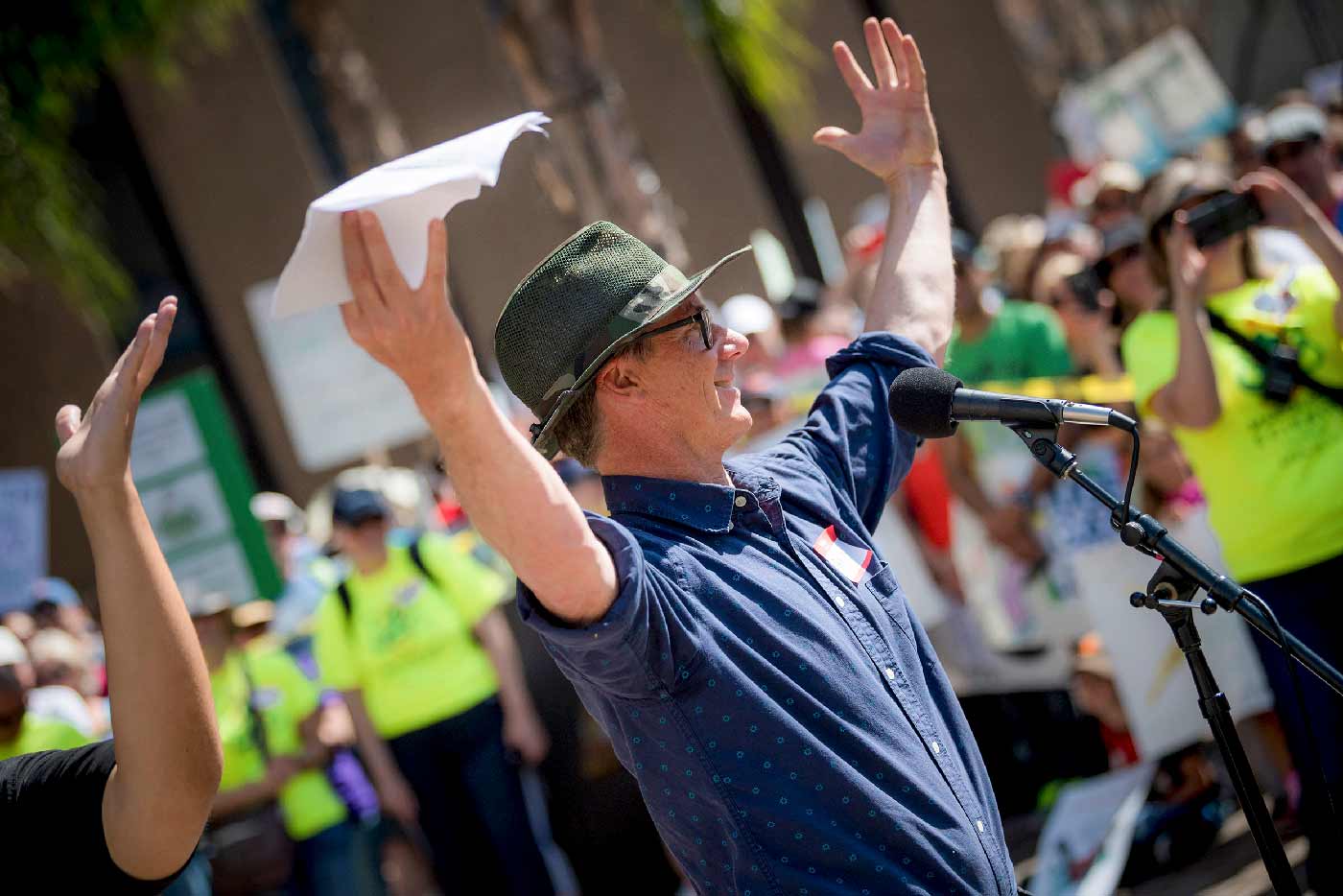
“The climate change debate has been over for decades,” Keeling said to the gathered crowd. “But just because we know we have a problem doesn't mean we understand in detail what the future will bring. Further scientific research is essential, not just to establish that the problem is real, but to help us cope with the very real threats to our prosperity and security.”
Kevin Tenerelli, an incoming M.D./Ph.D. student in the School of Medicine, patient advocate and parent of a child with a neurodevelopmental disorder, spoke about his path to a career in science and why his family was marching. A large part of his passion for science began with the birth of his first daughter, who was born blind. He later got involved in research for blinding eye diseases.
Lynne Talley, a professor of oceanography at Scripps Institution of Oceanography, also emphasized the importance of climate change mitigation in her remarks to the crowd. She was a lead author of the Intergovernmental Panel on Climate Change (IPCC) Fourth Assessment Report, which earned contributing scientists a share of the 2007 Nobel Peace Prize.
V.S. Ramachandran, a professor of psychology and neurosciences and director of the Center for Brain and Cognition at UC San Diego, opened the second set of talks held at the Science Expo that followed the march. “We’re celebrating this great adventure of the human mind, called science,” he said. “But let’s not forget that in addition to being a serious enterprise, science is also a lot of fun… When we think of science, we often think of technology, the fruits of science. All around you we have cars, planes, ships, cell phones, medical technology, moon landing. All of this is a product of science and worthy of celebration. It’s astonishing that we have achieved this. But let’s not forget that science also has an aesthetic dimension—it’s beautiful. It has more in common with poetry and visual arts and literature than people realize.”
Holding a surf board he made from algae, Stephen Mayfield, director of the California Center for Algae Biotechnology in the Division of Biological Sciences, told the crowd about his love for using science to solve problems. “But we also need to make sure that our political systems, our laws and our regulations, are also based on facts and science,” he said. “And we cannot do that working in the lab, we do that by voting, and talking—educating people about what we do and why it matters.”
School of Medicine postdoctoral researcher Keolu Fox also spoke at the expo. While his research focuses on genome sequencing and editing, Fox also co-founded IndiGenomics, a tribal non-profit organization with a mission of bringing genomic expertise to indigenous communities. His goal was to bring discussions of diversity to the march—not just diversity in ethnicity, gender and sexuality, but also diversity in the scientific culture, which leads to diverse ways of solving problems, he said.
WASHINGTON, D.C.
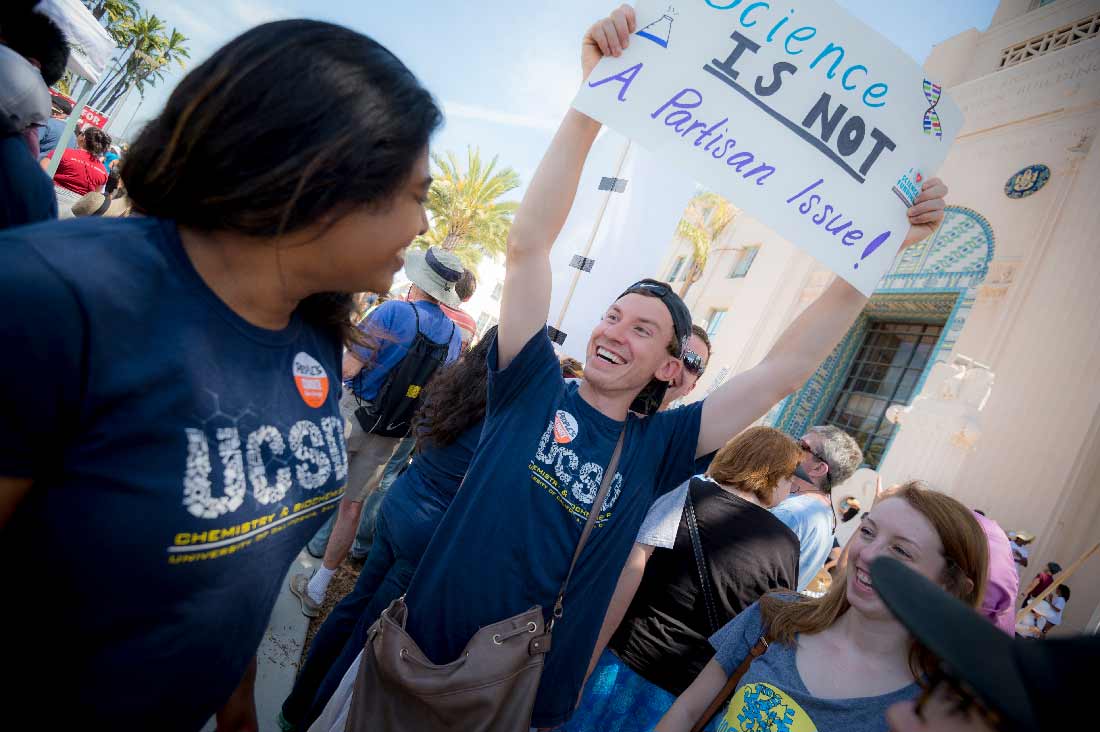
UC San Diego was also well-represented in Washington D.C. at the National March for Science, which began at the foot of the Washington Monument and ended at the Capitol building. Albert Yu-Min Lin, a UC San Diego research scientist, joined Bill Nye the Science Guy and other luminaries from the science world onstage at a pre-march teach-in to pump up the estimated 40,000 people in attendance. Lin earned his Ph.D. in materials science at UC San Diego in 2008 and is now a research scientist at the university’s Qualcomm Institute and co-founder of the science education company Planet3.
“I wouldn’t be standing here if it weren’t for science,” said Lin, referring both to his career and to the high-tech prosthetic leg he now wears as a result of an accident. “We are in a battle for science and that battle will be won or lost in our classrooms. We have an opportunity—or maybe more of a responsibility—to make ours the greatest science generation the world has ever seen.”
Also attending the event in D.C. were several affiliates of the Scripps Institution of Oceanography, as well as Steven Dowdy, a professor at UC San Diego School of Medicine. Dowdy said he was “very impressed with how many scientists and supporters of science came out on a cold, rainy day in D.C., which shows just how big of a problem we view the current situation.”
AND BEYOND
While everyone reported enjoying the marches, the question that remains on many minds is “what’s next?”
“We don’t want the enthusiasm for science we saw today to be just one march and we’re done,” said Robert Cooper, a UC San Diego postdoctoral researcher who helped organize the San Diego march. “We need to proactively work on better connecting scientists and the public. In a democracy, the public decides what to listen to and what to support, and we have no right to expect them to support science if we don't continuously put truth to our claim that science is for everyone.”
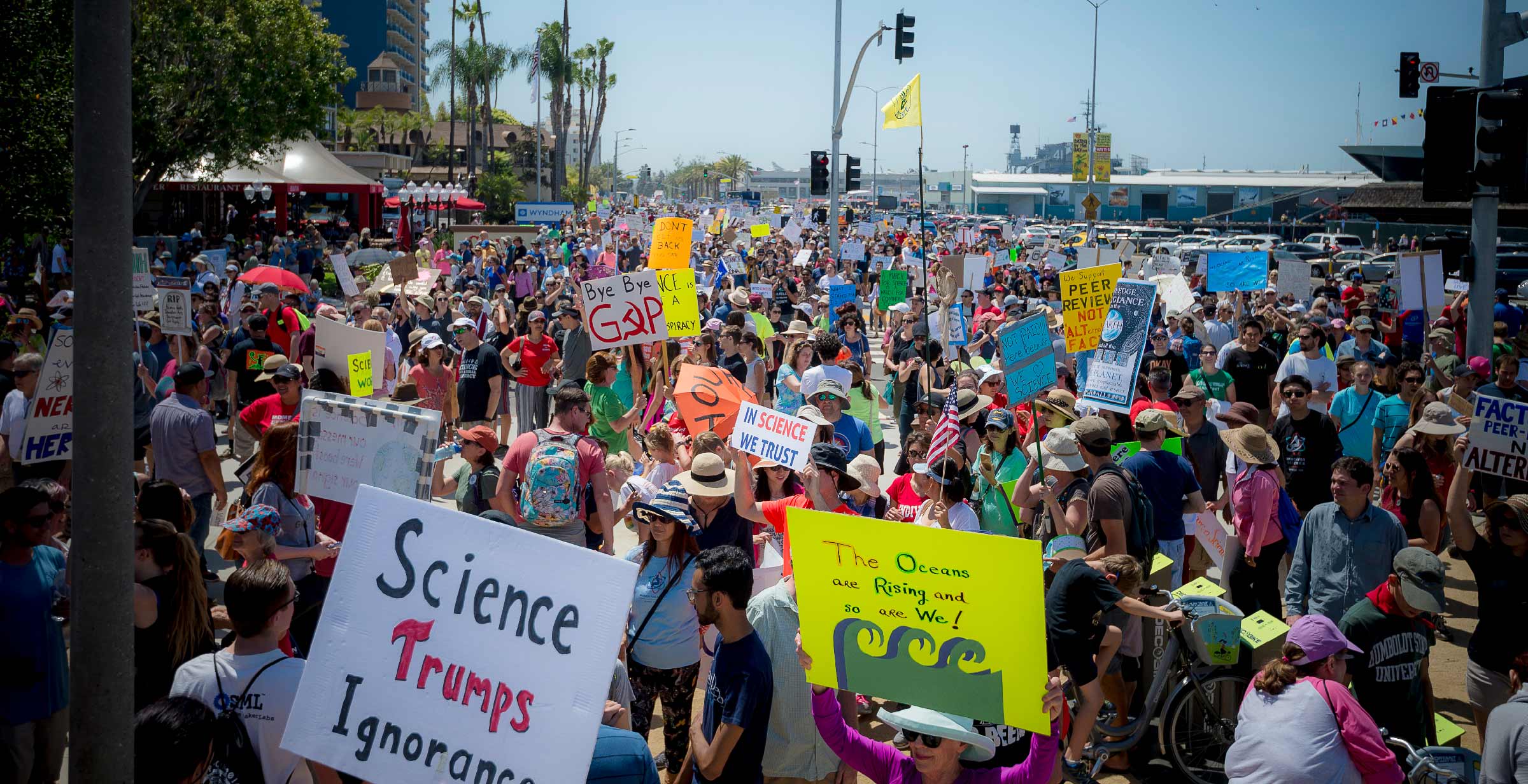
Many UC San Diego community members are already involved in efforts to increase public engagement in science. In San Diego, the science expo at the conclusion of the march featured several booths where UC San Diego students and staff explained their work and engaged attendees in demonstrations.
A team of undergraduate students was on hand to share the Saltman Quarterly, the biological research journal they produce. According to online reporter and Thurgood Marshall College freshman Sharada Saraf, their goal is to make complicated biological topics more accessible to a wider audience.
Anastasia Gromova, a second-year graduate student in the Biomedical Sciences Program, was sitting next to a sign that said “We are scientists. Ask us anything!” She’s a volunteer with Two Scientists Walk into a Bar, a Fleet Science Center program in which scientists engage with the public in local bars. Gromova said the effort helps get people interested in science and helps show that scientists are regular, approachable people, too.
For his part, D.C. marcher Dowdy said he plans to continue the momentum generated by the event by visiting high schools to “make sure the next generation of voting citizens understands the difference between evidence- and fact-based decision-making versus unsubstantiated opinions, ideology and fake hyperbole.”
San Diego march speaker Fox also encouraged attendees to speak up—not just with the public, but also with members of Congress. “Hold people responsible, especially anyone peddling fake news or fake data. Write to your senators or representative about the causes you believe in,” he said.
To help do this, the University of California Office of the President recently launched a new program called the UC Advocacy Network (UCAN). You can sign up for email updates and download their toolkit to find talking points and fact sheets on how UC research drives our economy forward, as well as guidance for talking to members of Congress and using social media to advocate for federal investments in research.
“Ultimately, I think the most important indicator for our long-term success was how many kids turned out and had fun,” Cooper said, describing the San Diego March for Science. “Our middle school speakers did an amazing job, and we had many kids engaged in the demos at the expo. This demonstrates that we were able to reach the next generation, and hopefully inspire them to make science a meaningful part of their lives, no matter what their eventual career paths.”
Share This:
You May Also Like
Stay in the Know
Keep up with all the latest from UC San Diego. Subscribe to the newsletter today.


